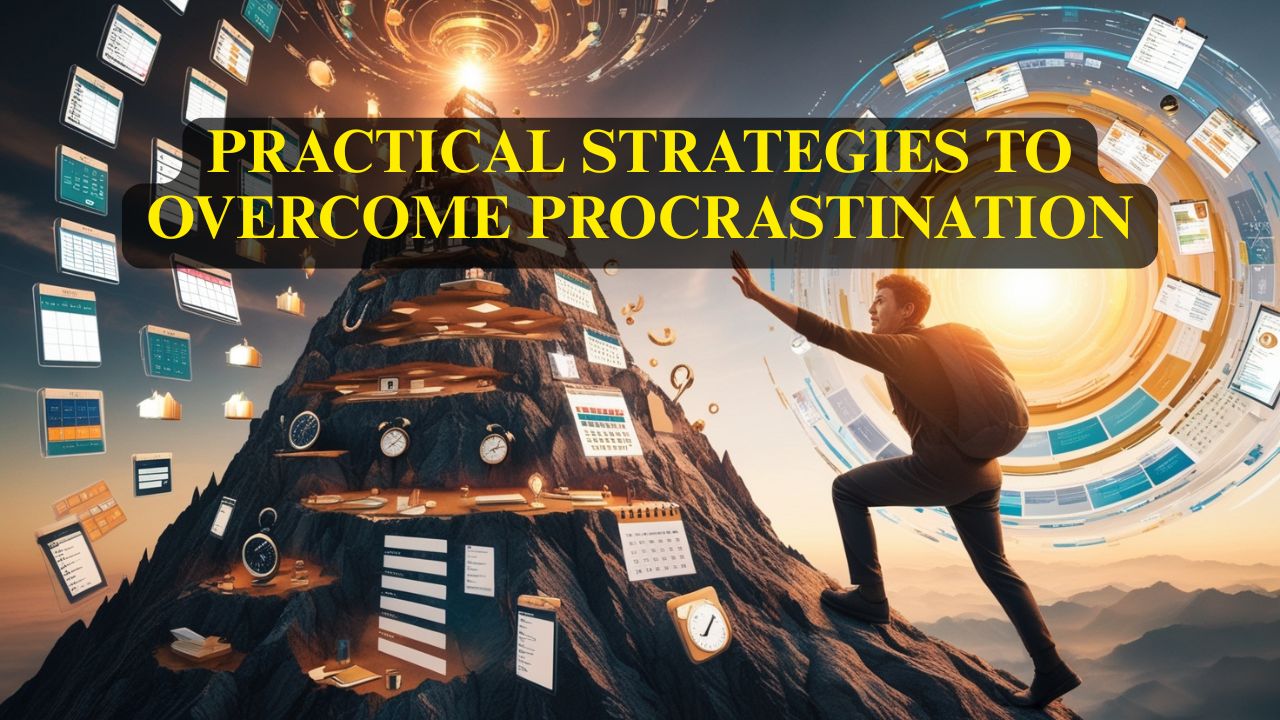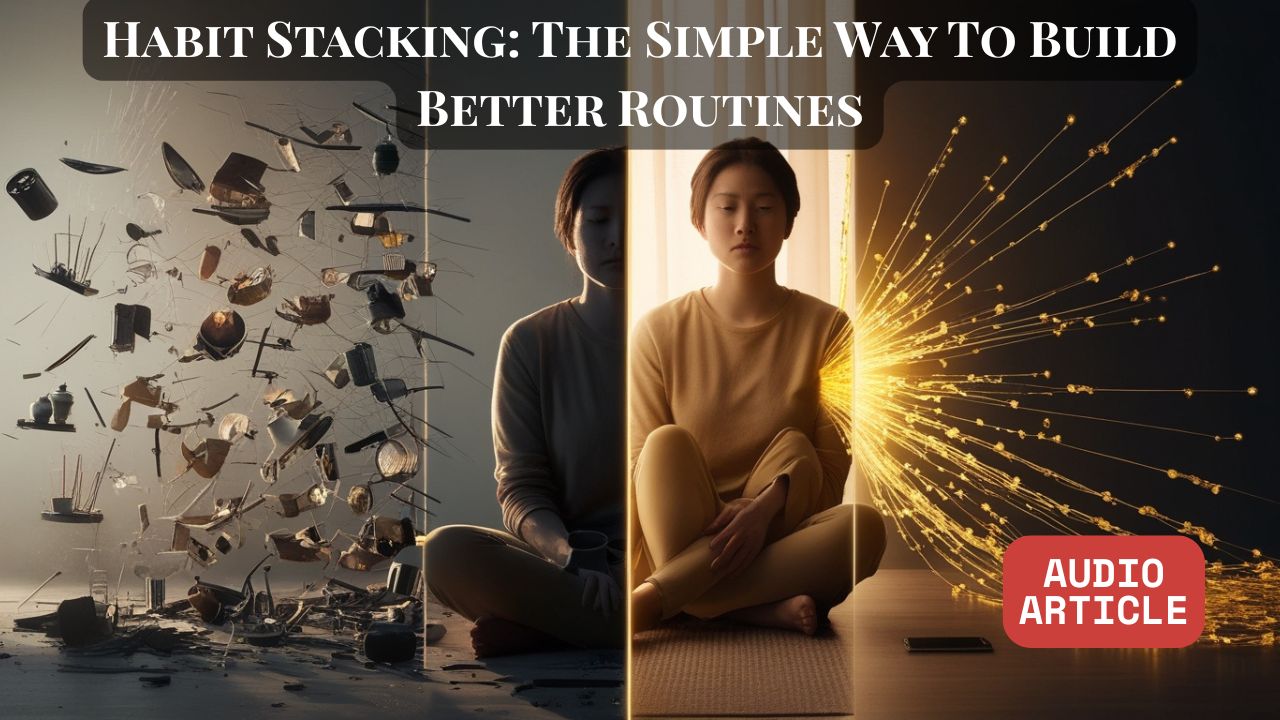Habit Stacking: The Simple Way to Build Better Routines
January first rolls around, and you're fired up. This is the year you're going to meditate daily, exercise regularly, eat healthy, read more books, and finally get your life together. You start strong for a few days, maybe even a couple of weeks. Then life gets busy, you miss a day, then another, and before you know it, you're back to your old patterns, wondering why you can't seem to stick to anything.
Sound familiar? If you've ever struggled to build new habits, you're not alone. Most people approach habit change with pure willpower and motivation, which works great until willpower runs out - and it always runs out.
But there's a smarter way. Instead of relying on motivation to remember and execute new behaviors, you can attach them to things you already do automatically. This is called habit stacking, and it's one of the most effective strategies for building lasting change.
Why Willpower Alone Doesn't Work
Before we dive into habit stacking, let's understand why the traditional approach to habit change fails so often. Most people think building habits is about having enough discipline or wanting change badly enough. If you just try harder and care more, you'll stick to your new routine, right?
Wrong. Willpower is like a muscle that gets tired with use. You might have plenty of self-control first thing in the morning, but by the time you've made dozens of decisions throughout the day, dealt with stress, and handled various challenges, your willpower reserves are depleted. This is why so many people start their day with good intentions but end up skipping their evening workout or grabbing fast food for dinner.
Research shows that people who seem to have great self-discipline actually structure their lives to avoid relying on willpower in the first place. They create systems and environments that make good choices automatic rather than constantly fighting internal battles about what to do.
Think about the habits you already have that you never struggle with. You probably don't need willpower to brush your teeth, check your phone when you wake up, or put on your seatbelt when you get in the car. These behaviors have become automatic through repetition and association with other activities.
The goal isn't to develop superhuman willpower - it's to make new behaviors as automatic as the ones you already do without thinking. This is where habit stacking comes in.
The Science of Habit Formation Made Simple
To understand why habit stacking works so well, you need to understand how habits actually form in your brain. Every habit follows the same basic pattern: there's a cue that triggers the behavior, you perform the routine, and then you get some kind of reward.
The cue is what signals your brain to start the habit. It might be a time of day, a location, an emotion, or another behavior. The routine is the actual habit - the thing you do. The reward is what makes your brain want to repeat the behavior in the future.
For example, let's say you have a habit of checking social media. The cue might be feeling bored or seeing your phone. The routine is opening the app and scrolling. The reward is the stimulation and social connection you get from seeing what others are posting.
Your brain loves patterns and is constantly looking for ways to save energy by making behaviors automatic. Once a habit is established, your brain can execute it without much conscious thought, freeing up mental energy for other things.
The challenge with building new habits is that your brain doesn't have an established neural pathway for the new behavior yet. You have to consciously remember to do it, which requires mental energy and is easy to forget when you're busy or distracted.
But here's the key insight: you can borrow the neural pathways from existing habits to help establish new ones. When you attach a new behavior to something you already do automatically, you're essentially piggybacking on an established pattern in your brain.
How to Attach New Habits to Existing Ones
Habit stacking follows a simple formula: "After I [current habit], I will [new habit]." You identify something you already do consistently and use it as the cue for your new behavior.
The beauty of this approach is that you don't have to remember to do the new habit - you just have to remember to do it after something you're already doing. Since the existing habit is automatic, it serves as a built-in reminder for the new behavior.
Let's look at some examples:
Morning Routine Stacking
- After I pour my first cup of coffee, I will write down three things I'm grateful for.
- After I sit down at my desk, I will take five deep breaths before starting work.
- After I brush my teeth, I will do ten push-ups.
Work Day Stacking
- After I sit down at my desk, I will review my priorities for the day.
- After I finish lunch, I will take a five-minute walk outside.
- After I close my laptop, I will spend two minutes tidying my workspace.
Evening Routine Stacking
- After I put on my pajamas, I will read for ten minutes.
- After I set my alarm, I will write down one thing I accomplished today.
- After I turn off the TV, I will prepare my clothes for tomorrow.
The key is to choose an existing habit that's already solid and consistent. If you sometimes skip breakfast, don't use "after I eat breakfast" as your cue. Instead, pick something you literally never miss, like "after I wake up" or "after I get out of bed."
Also, start small with your new habit. Don't try to stack "run five miles" onto an existing routine. Instead, start with "put on my running shoes" or "walk to the end of the block." You can always build up once the basic pattern is established.
Choosing the Right Anchor Habits
Not all existing habits make good anchors for new behaviors. The best anchor habits are things you do consistently, at roughly the same time, and in the same context. Here are some characteristics of strong anchor habits:
Frequency and Consistency Choose habits you do every single day, preferably at the same time. "After I brush my teeth in the morning" is much better than "after I go to the gym" if you only go to the gym three times a week.
Clear Beginning and End The anchor habit should have a clear completion point that can serve as the cue for your new behavior. "After I sit down at my desk" is better than "while I'm working" because sitting down is a specific moment, while working is a long, vague period.
Similar Context Try to stack habits that make sense in the same environment or mindset. If you want to build a meditation habit, stacking it after your morning coffee while you're still in a calm, reflective state makes more sense than attaching it to finishing a workout when you're energized and active.
Natural Flow Look for ways to create a logical sequence where one habit naturally leads to another. "After I put on my workout clothes, I will do five minutes of stretching" flows better than "after I check my email, I will do five minutes of stretching."
Some of the most reliable anchor habits include:
- Getting out of bed
- Brushing your teeth
- Pouring your first cup of coffee
- Sitting down at your desk
- Eating meals
- Getting in your car
- Putting on pajamas
- Setting your alarm
- Turning off lights before bed
Building Habit Chains
Once you've successfully established one habit stack, you can start building chains of behaviors that flow naturally from one to the next. This is where habit stacking becomes really powerful - you can create entire routines that run almost automatically.
For example, a morning routine chain might look like this:
- After I get out of bed, I will make my bed.
- After I make my bed, I will drink a glass of water.
- After I drink water, I will do five minutes of stretching.
- After I stretch, I will meditate for five minutes.
- After I meditate, I will write down my priorities for the day.
Each habit becomes the anchor for the next one, creating a seamless flow of positive behaviors. The key is to build these chains gradually. Start with just one or two habits, get those solid, then add the next link in the chain.
Be careful not to make your chains too long initially. If one link breaks, it can disrupt the entire sequence. It's better to have several shorter, solid chains than one long, fragile one.
You can also create context-specific chains for different parts of your day or different situations:
- A work startup routine
- A pre-workout sequence
- An evening wind-down routine
- A weekend morning flow
Troubleshooting When Habits Don't Stick
Even with habit stacking, sometimes new behaviors don't stick as easily as you'd hope. Here are the most common problems and how to solve them:
The Anchor Habit Isn't Strong Enough If you keep forgetting to do your new habit, the issue might be that your anchor habit isn't as automatic as you thought. Choose something you literally never skip, even on weekends, sick days, or when traveling.
The New Habit Is Too Big Most people make their new habits too ambitious. If you're trying to stack "exercise for 30 minutes," try scaling it back to "put on workout clothes" or "do one push-up." You can always do more once you show up, but the goal is to establish the pattern first.
The Connection Isn't Clear Make sure there's a clear, immediate connection between your anchor habit and your new behavior. "After I finish dinner, I will go for a walk" works better than "after I eat dinner, I will eventually exercise sometime in the evening."
Environmental Obstacles If your new habit requires specific tools or setup, make sure everything is ready in advance. If you want to read after you get in bed, keep the book on your nightstand. If you want to meditate after your morning coffee, have your meditation app ready to go.
Perfectionism Don't let perfectionism derail your progress. If you miss a day, just get back to it the next day. The goal is consistency over time, not perfection. Missing once doesn't ruin the habit - only quitting does.
Wrong Timing Sometimes the timing of your habit stack doesn't work with your energy levels or schedule. If you're trying to meditate after your morning coffee but you're always rushed at that time, try a different anchor or a different new habit that fits better with your morning energy.
Advanced Habit Stacking Strategies
Once you've mastered basic habit stacking, here are some advanced strategies to make your new routines even more effective:
Temptation Bundling Combine something you need to do with something you want to do. For example: "After I start my treadmill, I will listen to my favorite podcast" or "After I open my book, I will have a cup of my favorite tea." This makes the new habit more enjoyable and gives you extra motivation to follow through.
Environmental Stacking Instead of using a behavior as your cue, use a location or environmental change. "When I walk into my kitchen in the morning, I will drink a glass of water" or "When I sit in my car, I will take three deep breaths before starting the engine."
Time-Based Stacking While habit stacking usually works better than time-based habits, you can combine both approaches: "At 7 AM, after I pour my coffee, I will review my calendar for the day." This gives you both a time cue and a behavioral cue.
Identity-Based Stacking Connect your habit stack to the identity you want to develop. Instead of just "after I brush my teeth, I will floss," think "after I brush my teeth, I will floss because I'm someone who takes care of my health." This mental connection strengthens your commitment to the new behavior.
Habit Stacking for Different Life Areas
Habit stacking can be applied to virtually any area where you want to create positive change:
Health and Fitness
- After I put on my shoes, I will walk to the end of the block.
- After I eat lunch, I will take the stairs instead of the elevator.
- After I sit down for dinner, I will put my fork down between bites.
Personal Development
- After I start my car, I will listen to an educational podcast.
- After I close my laptop at work, I will read one page of a book.
- After I set my alarm, I will reflect on one thing I learned today.
Relationships
- After I pour my morning coffee, I will text someone I care about.
- After I get home from work, I will ask my partner about their day before checking my phone.
- After I sit down for dinner, I will share one highlight from my day.
Organization and Productivity
- After I finish a work task, I will immediately file or organize any related materials.
- After I walk into my home, I will put my keys in their designated spot.
- After I finish using something, I will put it back where it belongs.
Creating Your Personal Habit Stack System
Here's how to design a habit stacking system that works for your specific life and goals:
Step 1: Audit Your Current Habits Make a list of things you already do consistently every day. Include everything from brushing your teeth to checking your phone to eating meals. These are your potential anchor habits.
Step 2: Identify Your Goals What positive changes do you want to make? Be specific but start small. Instead of "get in shape," think "do some form of movement daily." Instead of "be more organized," think "keep my workspace tidy."
Step 3: Match Habits to Anchors Look for natural connections between your existing habits and your desired new behaviors. Consider timing, location, energy levels, and logical flow.
Step 4: Start with One Choose just one habit stack to begin with. Get that solid before adding more. This might take anywhere from a few weeks to a few months.
Step 5: Track Your Progress Keep it simple - just mark whether you did the habit or not each day. This isn't about perfection; it's about awareness and gradual improvement.
Step 6: Adjust as Needed If something isn't working, don't abandon the whole approach. Try a different anchor habit, make the new behavior smaller, or adjust the timing.
The Long-Term Power of Small Changes
The magic of habit stacking isn't in any single habit - it's in the compound effect of small, consistent changes over time. When you stack one small positive behavior after another, they start to add up in ways that can transform your entire day and, eventually, your life.
Imagine if you added just five minutes of reading after your morning coffee, two minutes of gratitude practice after you brush your teeth, and a five-minute walk after lunch. That's only twelve minutes of new activity, but over a year, that's 73 hours of reading, 12 hours of gratitude practice, and 30 hours of additional walking.
More importantly, these small habits often trigger bigger changes. The person who starts flossing one tooth often ends up flossing all their teeth. The person who commits to one push-up often ends up doing a full workout. The person who reads for five minutes often finds themselves reading for much longer.
Remember: Systems Beat Goals
Habit stacking is ultimately about creating systems rather than just pursuing goals. Goals are about the results you want to achieve; systems are about the processes that lead to those results. When you focus on building good systems through habit stacking, the results tend to take care of themselves.
The person who builds a system for daily exercise will get in shape. The person who builds a system for continuous learning will become knowledgeable. The person who builds a system for regular connection will have strong relationships.
Start Where You Are, Start Small
You don't need to overhaul your entire life to benefit from habit stacking. Start with one small behavior attached to something you already do consistently. Make it so easy that you can't say no. Focus on showing up rather than performing perfectly.
Your current habits took years to develop, and new ones won't establish overnight. Be patient with the process and trust that small, consistent actions compound into significant changes over time.
The beauty of habit stacking is that it meets you where you are and builds on what you're already doing well. You're not starting from scratch - you're simply adding small improvements to the foundation you've already built.
Every positive change starts with a single step, and that step becomes much easier when it's connected to something you're already doing. Your future self is shaped by the systems you build today, one small habit stack at a time.






